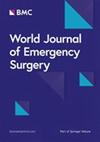Development and external validation of an artificial intelligence model for predicting mortality and prolonged ICU stay in postoperative critically ill patients: a retrospective study
IF 5.8
1区 医学
Q1 EMERGENCY MEDICINE
引用次数: 0
Abstract
Existing predictive models in critical care, specifically for postoperative critically ill patients, often struggle to accurately predict prolonged intensive care unit (ICU) stays, a key aspect of patient care. The integration of artificial intelligence (AI) offers a promising approach for bridging this gap. We aimed to develop an AI-based model to predict mortality and prolonged ICU stay in postoperative critically ill patients, enhance prognostic accuracy, and address the shortcomings of current models. This retrospective study included data from 6,029 postoperative critically ill patients from two medical centers, including a wide range of clinical, surgical, and laboratory variables. Multiple machine-learning models, including extreme gradient boosting, light gradient boosting, category boosting, random forest, and multilayer perceptron, were employed. A soft-voting ensemble model was developed to aggregate the strengths of individual models. The models underwent external validation, and the SHapley Additive exPlanations (SHAP) method was utilized to assess the impact of various features on predictions. In internal validation, the ensemble model demonstrated superior performance with an area under the receiver operating characteristic curve (AUROC) of 0.8812 for mortality and 0.7944 for prolonged ICU stay. It achieved 0.9095 accuracy and an F1 score of 0.7014 for mortality predictions. For prolonged ICU stay, it attained an accuracy of 0.9368 and an F1 score of 0.5762. During external validation, the model maintained high performance, with an AUROC of 0.8330 for mortality and 0.7376 for prolonged ICU stay. It showed 0.9200 accuracy and an F1 score of 0.6768 for mortality and 0.9028 accuracy with an F1 score of 0.5689 for prolonged ICU stay. SHAP analysis confirmed that key predictors, including emergency surgery, serum osmolality, lactate levels, and diastolic blood pressure, remained significant. This study represents a significant advancement in the application of AI in critical care, especially for postoperative critically ill patients. The developed AI model outperformed existing models in predicting mortality and prolonged ICU stay, demonstrating notable accuracy and reliability. Its ability to identify critical, under-emphasized clinical factors could enhance decision-making in critical care settings. Although promising, further validation in diverse clinical settings is essential to confirm the model’s efficacy and broader applicability.用于预测术后危重患者死亡率和延长ICU住院时间的人工智能模型的开发和外部验证:一项回顾性研究
现有的重症监护预测模型,特别是对于术后危重患者,往往难以准确预测重症监护病房(ICU)的延长时间,这是患者护理的一个关键方面。人工智能(AI)的集成为弥合这一差距提供了一种有希望的方法。我们的目的是建立一个基于人工智能的模型来预测术后重症患者的死亡率和延长ICU住院时间,提高预后准确性,并解决当前模型的不足。这项回顾性研究包括来自两个医疗中心的6029名术后危重患者的数据,包括广泛的临床、外科和实验室变量。采用了多种机器学习模型,包括极端梯度增强、轻梯度增强、类别增强、随机森林和多层感知器。开发了一个软投票集成模型来汇总各个模型的优势。模型进行了外部验证,并使用SHapley加性解释(SHAP)方法来评估各种特征对预测的影响。在内部验证中,该集成模型表现出优越的性能,死亡率的受试者工作特征曲线下面积(AUROC)为0.8812,延长ICU住院时间的AUROC为0.7944。在死亡率预测方面,它的准确率达到了0.9095,F1得分为0.7014。对于延长ICU住院时间,准确率为0.9368,F1评分为0.5762。在外部验证中,模型保持了较高的性能,死亡率的AUROC为0.8330,ICU住院时间延长的AUROC为0.7376。准确度为0.9200,死亡率F1评分为0.6768;准确度为0.9028,延长ICU住院时间F1评分为0.5689。SHAP分析证实,包括急诊手术、血清渗透压、乳酸水平和舒张压在内的关键预测因素仍然显著。这项研究代表了人工智能在重症监护中的应用取得了重大进展,特别是在术后危重患者中。开发的人工智能模型在预测死亡率和ICU住院时间方面优于现有模型,显示出显著的准确性和可靠性。它识别关键的、被忽视的临床因素的能力可以提高重症监护环境中的决策能力。虽然很有希望,但为了确认该模型的有效性和更广泛的适用性,在不同的临床环境中进一步验证是必不可少的。
本文章由计算机程序翻译,如有差异,请以英文原文为准。
求助全文
约1分钟内获得全文
求助全文
来源期刊

World Journal of Emergency Surgery
EMERGENCY MEDICINE-SURGERY
CiteScore
14.50
自引率
5.00%
发文量
60
审稿时长
10 weeks
期刊介绍:
The World Journal of Emergency Surgery is an open access, peer-reviewed journal covering all facets of clinical and basic research in traumatic and non-traumatic emergency surgery and related fields. Topics include emergency surgery, acute care surgery, trauma surgery, intensive care, trauma management, and resuscitation, among others.
 求助内容:
求助内容: 应助结果提醒方式:
应助结果提醒方式:


